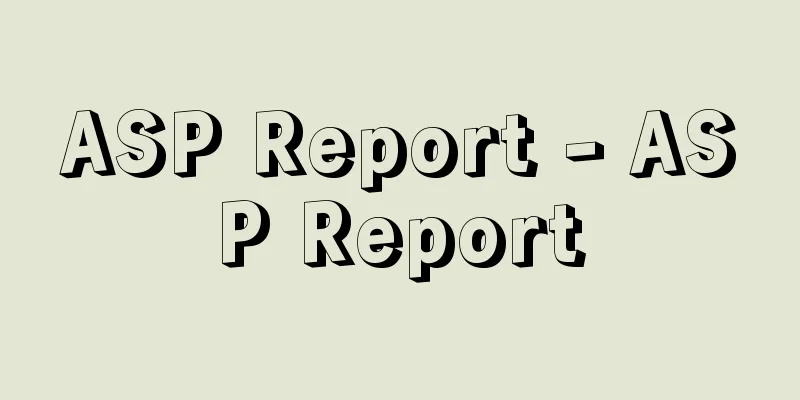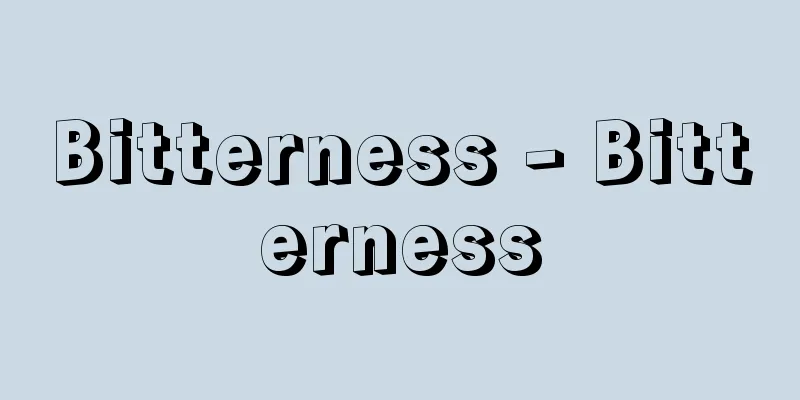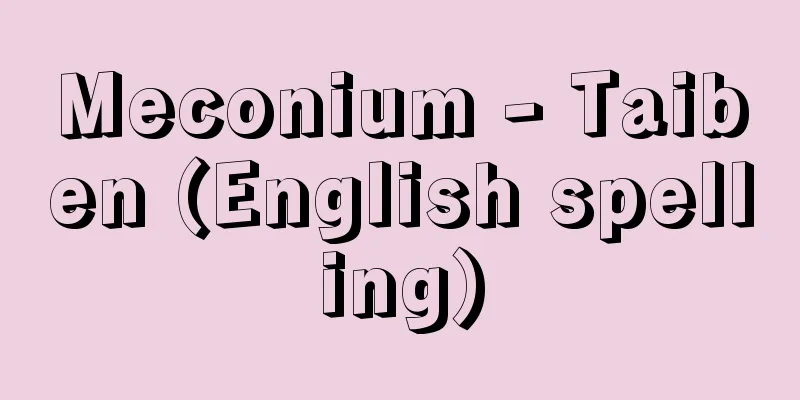Cardboard - Itagami (English spelling) cardboard

|
A general term for thick paper, also known as cardboard. Paperboard is hard and stiff. There are many types of paperboard, including yellowboard, whiteboard, chipboard, and kraft liner, and it is often used for cardboard base paper and paper boxes. After World War II, Japan experienced a shortage of all resources, especially softwood, which meant that wooden boxes could not be made, making packaging and transportation difficult. However, cardboard boxes made of laminated paperboard began to spread, making packaging and transportation easier. Moreover, empty boxes could be folded and collected, and then reused as boxes. Empty boxes that could no longer be used could be crushed and collected as waste paper, which could then be recycled into paperboard, leading to an explosive increase in production and demand. Paperboard production exceeded 10 million tons per year in the late 1980s, reaching 12.79 million tons in 2000, but production has been declining since then, reaching only 11.36 million tons in 2014. During this period, paperboard production accounted for approximately 40% of the total production of paper (western paper) and paperboard. Almost 100% of the raw material for paperboard is recovered waste paper, which is one of the few inexhaustible resources in Japan, a resource-poor country, and is also renewable. Today, when paperboard consumption has begun to decline, if everyone can pool their ideas and create new, convenient paperboard products and new demand, paperboard production in Japan can be increased immediately, and old paperboard can be turned into recycled pulp and recycled into paperboard, preventing waste paperboard from becoming garbage and bringing convenience and prosperity to society. [Akio Mita April 18, 2016] Raw material for paperboardIn the past, paperboard was made from a mixture of wood-based chemical pulp such as sulfite pulp, kraft pulp, semi-chemical pulp, mechanical pulp, straw pulp from non-wood-based raw materials, and recycled pulp from waste paper, all of which were made on a paperboard machine. Later, due to the strengthening of waste paper collection to reduce urban waste and the influence of campaigns to protect wood resources and forests, the recovery rate of waste paper in Japan exceeded 60% in 2001 and 80% in 2013. The thinner the paper, the more stringent the raw materials are, and the higher the quality of the pulp is preferred, so waste paper has come to be used more frequently as a raw material for thicker paper, especially paperboard, and as of 2014, 93.2% of all waste paper was used as a raw material for paperboard. Due to these circumstances, research and development of technologies such as dust removal, deinking, and screening has been carried out, and the quality of recycled pulp has improved. During papermaking, strength enhancers such as polyacrylamide are also added. As a result, many paperboards are now made with nearly 100% recycled pulp. As a result, many of the paperboards that were once named after their raw materials, such as semi-core, kraft liner, and manila board, now contain little or no wood pulp or hemp pulp and only retain their names. [Akio Mita April 18, 2016] Paper MachineAmong paperboards, thin semi-medium and kraft liner have a single layer structure and are usually made on a fourdrinier papermaking machine or twin wire papermaking machine. On the other hand, thick paper has a multi-layer structure and is usually made on a cylinder papermaking machine. A cylinder papermaking machine has 1-8 cylinders in the wet section, and each cylinder uses a different type of pulp to form a wet paper (a thin layer of wet paper), which is then pressed into a single sheet of wet paper by squeezing the water out in the press section, and then heated and dried in the dryer section to produce thick paper. With a cylinder papermaking machine, white pulp can be used for the outer cylinders, low-quality recycled pulp for the middle layer, and deinked pulp for the bottom layer to produce white board. As a result, it is used as a typical papermaking machine for paperboard because it can produce relatively high-quality board at low cost even with low-quality raw materials. [Akio Mita April 18, 2016] Representative types of paperboardKraft liner, the paperboard used on the top and bottom of cardboard, was once made from kraft pulp made from wood. Later, it was made by mixing recycled kraft pulp, but now most paper is made from general recycled paper pulp as the main ingredient, with recycled kraft pulp and other ingredients mixed in as secondary ingredients. The corrugated semi-core of cardboard was originally made from neutral sulfite semi-chemical pulp made from wood chips. Later, it was mixed with recycled pulp from cardboard waste paper, but now it is made from almost 100% general recycled paper pulp. The combined production volume of liner and core base paper used as base paper for cardboard reached 9.1 million tons in 2014, accounting for about 80% of all paperboard. Representative types of paperboard for paper containers include white board, chipboard, and yellow board. White board includes manila board and white board, both of which are coated or uncoated, and the coated version is used for fine color printing. Manila board is made by combining raw materials such as bleached pulp on both sides and recycled waste paper pulp in the middle layer. In addition to postcards, cards, and illustrated books, there is demand for lightweight printed boxes for food and cosmetics. It also has folding strength, so it is used as a folding box for sweets and other items. White board is made by combining bleached pulp on the surface, recycled pulp from the backing in the middle layer, and pulp or recycled waste paper pulp on the back. White board is printed and is the most common paper box for storing miscellaneous goods, detergents, etc. Chipboard is a paperboard made by multi-layering using recycled pulp from low-grade waste paper, and is used for machine boxes, pasting boxes, backing boards, etc. Yellow board is a paperboard that was once mass-produced by mixing lime straw pulp with recycled pulp from waste paper, and includes yellow board and white-yellow board. It was used for stencils because it can be processed for precise punching, as well as for assembled boxes, hard covers for hardcover books, and paper tubes. Although straw is still available in Japan today, lime straw pulp can no longer be produced due to the difficulties involved in treating the waste liquid. There are many other types of paperboard, including paper tube base paper, wrapping used for packaging paper pulp, gypsum board base paper for building materials, and waterproof base paper. [Akio Mita April 18, 2016] "Current Status of the Paper and Pulp Industry" edited and published by the Japan Paper Association (Monthly "Paper and Pulp" 2001 Special Issue, 2001)" [Reference] | | | | | |Waste | | | |Source: Shogakukan Encyclopedia Nipponica About Encyclopedia Nipponica Information | Legend |
|
厚い紙の総称でボール紙ともよばれる。板紙の紙質は硬く、腰が強い。黄板紙、白板紙、チップボール、クラフトライナーなど板紙の種類は多く、段ボール原紙や紙箱の原紙などに多く使われる。日本では第二次世界大戦後、あらゆる資源が不足したが、針葉樹材はとくに不足し、木箱ができず梱包(こんぽう)と輸送に苦労した。しかし板紙を張り合わせた段ボール箱が普及し始めたため、包装と輸送が容易になった。しかも空き箱は折りたたんで回収するとふたたび箱として利用でき、使えなくなった空き箱はつぶして古紙として回収し、いったん再生パルプとしたのち板紙を再生できるため、爆発的に生産と需要が増加した。板紙の生産量は、1980年代後半に年間1000万トンを突破し、2000年(平成12)には1279万トンとなったが、その後生産は下降ぎみで、2014年には1136万トンにとどまった。この間、板紙の生産量は、紙(洋紙)・板紙の全生産量の40%程度を占めている。 板紙の原料は、ほぼ100%が回収古紙であり、これは資源小国の日本にとっては数少ない無尽蔵ともいえる資源で、しかも再生可能な資源でもある。板紙の消費量が減り始めた今日、だれもがアイデアを持ち寄り、新しい便利な板紙製品と新規需要を生み出すことができれば、板紙は日本では即、増産可能であり、古い板紙が再生パルプとなり板紙に再生できるので、古板紙がごみにならないですみ、社会に便利さと豊かさをもたらすことになろう。 [御田昭雄 2016年4月18日] 板紙の原料かつて板紙は、木材を原料とする亜硫酸パルプ、クラフトパルプなどの化学パルプ、セミケミカルパルプ(半化学パルプ)、機械パルプのほか、非木材を原料とする藁(わら)パルプおよび古紙の再生パルプなどを配合し、板紙用抄紙機(しょうしき)で抄造した。その後、都市ごみの減量のため古紙の回収が強化されたことや、木材資源および森林保護などの運動の影響により、日本における古紙の回収率は2001年には60%、2013年には80%を突破するに至った。紙は薄い紙ほど原料に厳しく上質のパルプが好まれるため、厚手の紙、とくに板紙では原料として古紙が多用されることとなり、2014年時点では全古紙の93.2%が板紙原料として利用されている。またこのような事情から、除塵(じょじん)技術、脱墨技術、精選技術などの研究開発が行われ、再生パルプの品質は向上した。抄紙に際しては、ポリアクリルアミドなどの紙力増強剤も添加されている。こうして再生パルプの利用率がほぼ100%の板紙も多くなった。したがって、かつて原料にちなんで名前がつけられた、セミ中芯(なかしん)、クラフトライナー、マニラボールなどのなかには、原料にほとんど、あるいはまったく木材パルプや麻パルプを使わず、名称だけが残っている板紙も多い。 [御田昭雄 2016年4月18日] 抄紙機板紙のうち、薄手のセミ中芯やクラフトライナーなどは一層構造で、通常長網(ながあみ)抄紙機またはツインワイヤー抄紙機などで抄紙される。一方、厚手の紙は多層構造をもち、通常は円網(まるあみ)抄紙機による抄紙が行われる。円網抄紙機はウェットパートに1~8程度の円網をもち、各円網で違う種類のパルプを用いて湿紙(ぬれた薄い紙の層)を形成させ、プレスパートで水を絞って1枚の湿紙にし、さらにドライヤーパートで加熱乾燥することにより、厚手の紙を製造する。円網抄紙機では、表層となる円網には色白のパルプを、中間層には低質の再生パルプを、下層には脱墨パルプを用いて白板紙を生産することができる。このように下級原料を用いても比較的良質な板紙が安価に製造できるので、代表的な板紙の抄紙機として用いられている。 [御田昭雄 2016年4月18日] 代表的な板紙の種類段ボールの上下の両面に使われる板紙であるクラフトライナーには、かつては木材を原料としたクラフトパルプが用いられていた。その後クラフトの再生パルプを配合して抄紙されていたが、現在ではほとんどが一般の古紙再生パルプを主原料とし、クラフトの再生パルプなどが副原料として配合されて抄紙される。段ボールの波板状のセミ中芯は、当初は木材チップを原料とする中性亜硫酸セミケミカルパルプを原料として抄紙していた。その後、段ボール古紙の再生パルプなどを配合していたが、現在では一般の古紙再生パルプほぼ100%で抄紙されている。段ボールの原紙としてのライナーと中芯原紙の2014年の生産量合計は、全板紙の約80%の910万トンに達した。 紙器用板紙の代表的なものには、白板紙、チップボール、黄板紙などがある。白板紙にはマニラボールと白ボールがあり、いずれも塗工、非塗工のものがあり、塗工したものは精緻(せいち)なカラー印刷用紙として使われる。マニラボールは、両面が晒(さらし)パルプ、中層が古紙の再生パルプなどを原料として、抄(す)き合わせで製造する。絵葉書、カード類、図鑑などのほか、食品、化粧品類の軽量の印刷箱などの需要がある。また耐折強度もあるので、折りたたみ箱として菓子などの容器に利用される。白ボールは表層は晒パルプ、中層は台紙の再生パルプ、裏面はパルプまたは古紙の再生パルプなどから抄き合わせで製造される。白板紙は印刷を施され、雑貨や洗剤などを入れるもっとも一般的な紙箱として用いられる。 チップボールは下級古紙の再生パルプを用いて多層抄きして得られる板紙で、機械箱、貼(は)り箱、台紙などとして使用される。 黄板紙は、かつて石灰藁(わら)パルプを主原料として古紙の再生パルプなどを配合して大量に製造された板紙で、黄ボール、裏白黄ボールなどがある。緻密(ちみつ)な打ち抜き加工などができるため型紙などに使われたほか、組立て箱、上製本などの固い表紙、紙管などに用いられた。日本には現在でも原料の藁はあるが、廃液処理に困難を伴うため、石灰藁パルプが製造できなくなっている。 そのほかにも板紙の種類は多く、紙管原紙、紙パルプの包装に使うワンプ、建材用の石膏(せっこう)ボード原紙、防水原紙などがある。 [御田昭雄 2016年4月18日] 『日本製紙連合会編・刊『紙・パルプ産業の現状』(月刊『紙・パルプ』2001年特集号・2001)』 [参照項目] | | | | | | | | | |出典 小学館 日本大百科全書(ニッポニカ)日本大百科全書(ニッポニカ)について 情報 | 凡例 |
<<: Flat glass - Itagarasu (English spelling) Flat glass
>>: Itagaki Taisuke - Itagaki Taisuke
Recommend
Raku ware - Raku ware
A type of Japanese pottery. Raku ware can be broa...
Carassius auratus (English spelling)
...It is a breed of crucian carp (family Cyprinid...
Rice blast fungus - Rice blast fungus
...This is often due to the formation of new race...
Fú wáng (English: Fukuō)
1601‐48 An emperor established by the exiled gover...
Urban, C.
...R. Barker, who invented the "panorama&quo...
Hexadecanol
...A typical naturally occurring chain saturated ...
Faiguet de Villeneuve, J.
...The proportion of post-empirical languages a...
Tremolite (tremolite)
Also called tremolasite or tremola. A calcium amph...
verv' (English spelling) verv
...In ancient Russia, blood-related communities e...
Laelia flava (English spelling)
…Run [Koichi Ejiri]. . . *Some of the terminology...
Organic fertilizer - organic fertilizer
A fertilizer formed from organic components, it re...
packhawaj (English spelling)
...It is sometimes paired with a drum called a ba...
Apology Advertisement - Shazaikoukoku
One method of compensation for defamation is for t...
Mud crab
…It is found widely from Tokyo Bay south through ...
Fishing rights - gyogyōken
Based on the Fisheries Law, this is the right to ...



![Kochihira [town] - Kochinda](/upload/images/67cb962b06a73.webp)





